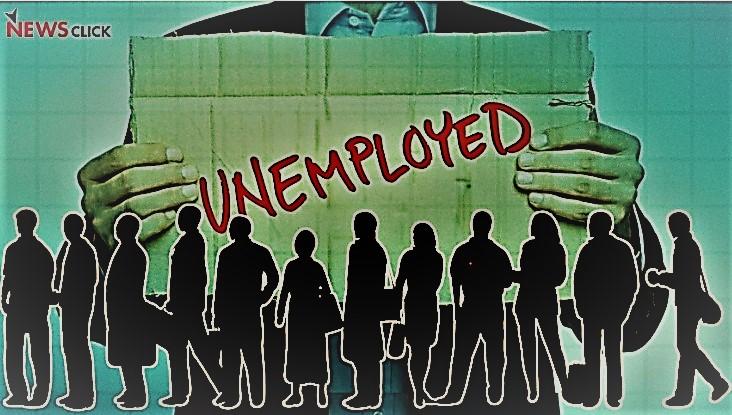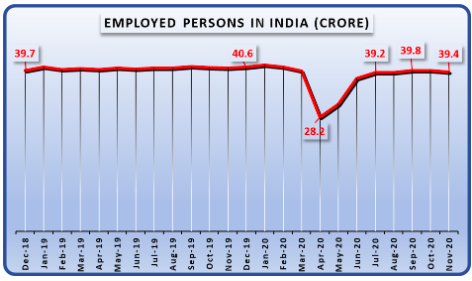Unemployment has inched up to over 9% as the year ends and the so-called economic recovery is a mirage.
Subodh Varma

For Indians, 2020 will go down in history as the worst year for livelihoods and incomes. Unemployment levels rose to record highs, incomes plummeted to record lows and such was the scale of deprivation that thousands of families teetered on the brink of starvation. Tragically, this was not just the pandemic. It was also the imposition of a sudden lockdown, the failure to provide income support, the insistence of the government to restrain expenditure and hope that the corporate captains will steer the sinking economy out of trouble. But, the most despairing aspect is that the bad days are not over.
For those living in the bubble of government propaganda, India’s devastated economy is supposed to be going through a “V-shaped recovery”. They see “green shoots” dancing and fluttering in the breeze everywhere. Addressing corporate bigwigs, Prime Minister Modi was pleased that the economy was recovering faster than expected. Among the pointers to this are better GST collections, increase in freight and port traffic, and most seductive of all – the stock market reaching record heights.
In the real world, things are quite the reverse. The biggest and most crucial of measures for any economic diagnosis is jobs. How many people are employed? How much is the unemployment rate? And, what share of the population is working? On all these counts things are worrying if not dire.
The chart below shows monthly unemployment rate for the past two years, starting December 2018, based on CMIE data. Till the lockdown in March 2020, the jobless rate was hovering at 7-8%, not a very happy situation. Then came the devastating blow of the lockdown which effectively shut down the country’s vast economy. Not surprisingly, the jobless rates soared – it was nearly 24% in April and about 22% in May this year. As economic activity was slowly permitted again, people rushed back to their mostly informal work at whatever earning rates they got. This led to a fall in jobless rate, though it didn’t do the economy much good because incomes were still much lower than before.
But now, look at the months following – July onwards, till December.
Unemployment rate 2020
As kharif harvesting ended there was a small uptick in October before the rabi sowing preparations began and unemployment rates dipped to 6.5% in November. This caused much celebration amongst the pro-government economists and TV show ‘experts’ who declared that the worst was over. But, the latest weekly data of CMIE from December shows that as of December 27, unemployment rate was up again to over 9%. In fact, it appears that joblessness has settled down at a new ‘normal’ of 8-9% in the post-lockdown period. This blows up any fond hopes of the ruling dispensation about the ‘recovery’.
Stagnating Employment
Now, look at another aspect of a crisis that refuses to go away – those who are actually working. The trend over the past two years, based again on CMIE survey data, is shown in the chart below. What will immediately strike you is that its flat – the number of employed persons were about 39.7 crore in December 2018, and it is 39.4 crore in November 2020. The lockdown effect is vividly brought out as employment crashed to just 28.2 crore in April and 31.4 crore in May this year. But after that it has slid back to the same plateau.
What does this mean? Population is growing every day, and it is estimated that about 12 crore people enter the working age population every year. Not all of these look for jobs. Some are still studying, women are usually told to get married shortly, and so on. The average work participation rate – the share of population that is willing to work – used to be about 42% before the lockdown. That means about five crore people join the army of job seekers every year. Yet, in two years, the employed persons’ number is the same. It is evident that people are either joining the vast army of unemployed, or defeated and discouraged, they are sitting at home, doing some piecemeal job once in a while, helping around in farming or other such family work.
In fact, the work participation rate shows this clearly. It has dipped from 42.5% in December 2018 to about 40% in November 2020.
Crisis Created by Modi Govt
India’s fragile economy was already in the grip of a crisis before the pandemic hit the country. Economic growth had slowed down, unemployment was rising, consumption expenditure was falling – in short, people were suffering immensely as their living standards fell. This is also reflected in the shocking extent of malnutrition as revealed in the recent National Family & Health Survey for 2018-19. The Modi government had shown itself to be completely unable to handle this crisis, wedded as it was to archaic notions of running an economy by allowing the private sector to take over most functions, and hoping for the bestand hoping for the best.

Protecting Employment and Creating Jobs Matters the Most
The government has in fact sought to use the pandemic to push through even more of the same dangerous medicine, by enacting the three farm laws and the four Labour Codes, which together will create more unemployment, reduce incomes further and lend more insecurity to the people.
In other words, the dire situation that is being seen today – rising joblessness, rising prices, falling incomes – is a precursor to even more of the same. It is beyond argument that a radical change in policies is desperately needed – or this government has to change.
SOURCE NEWS CLICK
{ With input from news agency language)
If you like this story, share it with a friend!
https://mitraspec.com?afmc=da&utm_campaign=da&utm_source=leaddyno&utm_medium=affiliate
We are a non-profit organization. Help us financially to keep our journalism free from government and corporate pressure.
















0 Comments